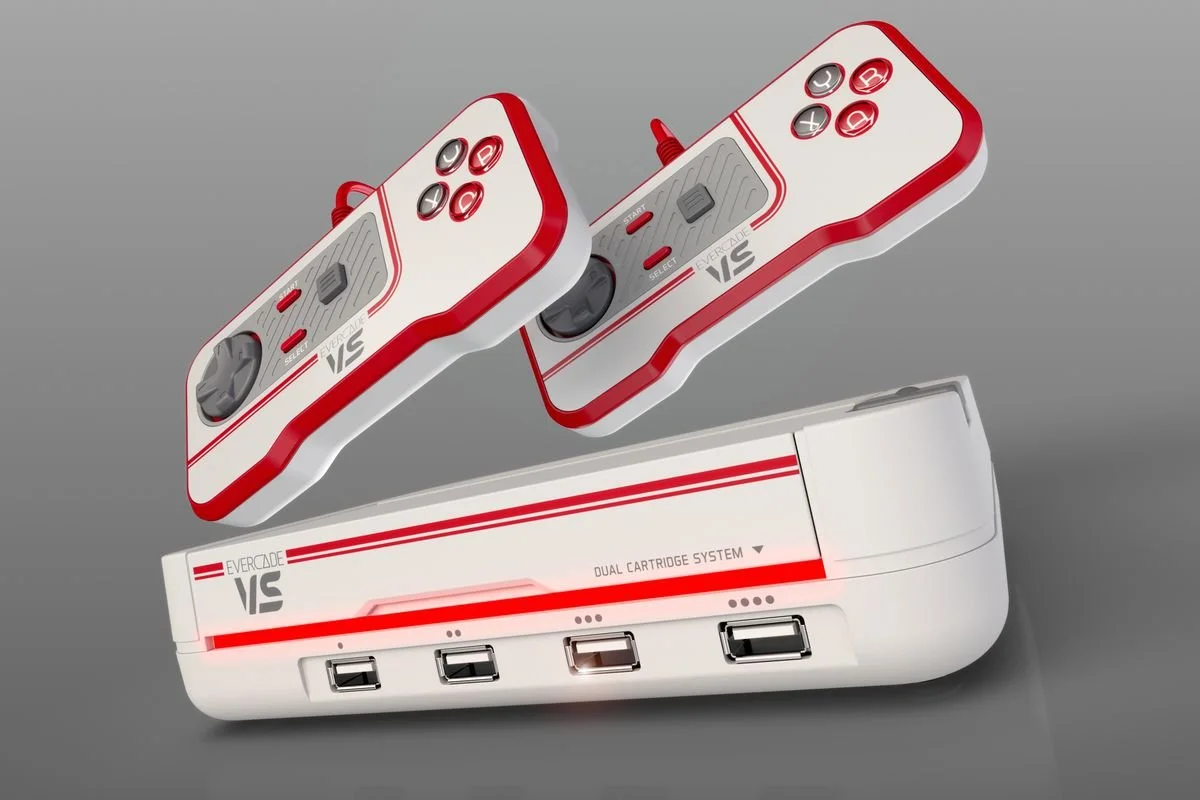Evercade VS Review
Regular listeners of the podcast will know that I spent a good chunk of time this year constructing the colloquially named ‘emulation station’: a portable, USB powered 4 terabyte hard drive that basically holds ROMs and disc images for every game released on any platform including, as well as prior to, the Dreamcast.
We’re talking tens of thousands of games. Organised, appended with box art and screenshots. Auto-launching in emulators that have been tweaked to offer minimal latency, maximum integer scaling, a range of control options, the works.
So why am I so taken with the Evercade brand? The recently expanded family of low cost machines designed to play small collections of retro games?
Curated choice.
I have to say, I’m incredibly taken with the design and presentation of the machine. I paid in early to secure a ‘Founder’s Edition’ console meaning it’s an exclusive black colourway, and every layer of the unboxing process was a joy.
Would I have played the SNES racer Battle Cars to completion if it wasn’t for the original Evercade Handheld? Would I have beaten the off-brand brawler Water Margin three times over? Would I have even heard of the 2020 Mega Drive homebrew title Arkagis Revolution or Codemaster’s lesser known NES classic Boomerang Kid?
The hard drive, for all its positives, can feel a little like the endless scroll of Netflix or Disney+ on a lazy evening. Boot it up, spend a lopsided hour browsing films and series you’ve never heard of for 40 minutes, then just settle on an episode of The Simpsons you remember watching last on Channel 4 when you were 11.
Even for me, someone who prides themselves on having a pretty wide reaching knowledge of platform libraries, an Evercade cartridge usually arrives with 75% of its wares a glorious unknown.
The Interplay Collection: Boogerman, Earthworm Jim, both well known, and great in their own janky, esoteric way. But the remainder? Games like Battle Chess, Incantation, Titan? This is the meat and potatoes of the Evercade experience. Come for the heavy hitters, stay for the deep cuts. They can’t all be winners. Time has not always been kind to games that relied on punishing difficulty or esoteric instruction to expand playtime, but there’s still a strange fun to finding a title you really do connect with.
I’m of a generation who bought albums. You may have heard a lead single on the wireless (or MTV2), that whet your appetite, but the joy was in buying a cassette, or CD, or vinyl record and listening through the before and after tracks that bookended the bop you bought it for originally. Some you’ll love, some you’ll feel indifferent to, but they all carry a value by virtue of curated inclusion. A band deliberating over a song-list on a studio whiteboard, listening to tracks in new-situ until they find their forever homes, nestled alongside tracks already pulled out for radio play.
Each Evercade cartridge carries with it a level of ceremony. The pre-release cycle where information is drip fed as each new license is revealed. Poring over the mini pieces of box art that adorn the back of each case when the thing drops through the letter box. The first skim of the manual. The click of the cart into the home console or handheld.
You may well rush for Double Dragon, or Pac Man, or Fantastic Dizzy. But it’s all those other gems sitting just to your peripheries that makes the brand such an exciting prospect.
The VS itself is a marvellous thing. I still have a lot of love for the original handheld, with its slightly oversized shell and lower resolution screen, but I’d be lying if I said the VS isn’t now the main way I’ll initially visit or eventually revisit these collections.
Over its year or so on the market, the Evercade Handheld has had its fair share of firmware updates. The UI has been refined, individual game bugs have been patched, even larger features like save state support has been tweaked so as to improve usability. And yet that home console interface is just that step above: so crisp and slick that it utterly betrays the console’s budget price.
The RGB light bar on the front of the machine is a pleasing novelty, and the controllers feel reassuringly sturdy, with their squarish designs actually sitting incredibly comfortably in the palm. It’s all powered by a simple micro USB cable meaning I can stick it straight into my TV for minimal power draw. All the features of the handheld are present and correct here, but have been refined, streamlined, or in some cases, reworked entirely to make sense across a larger canvas. It’s multiplayer now, with the VS offering up to 4 players in compatible games through its relatively universal USB inputs.
It’s not a Playstation 5 or a Series X. It’s not a Switch. It’s not even a last-gen machine. But it is now, without doubt, one of the best places to play legitimately licensed retro games. It’s not for everyone, but across the Evercade Handheld and VS and their ever expanding collections of multi-game collections, there’s a hell of a lot here to love.




